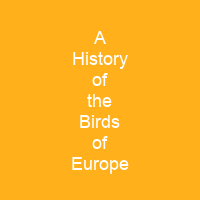Discovering the Rich Legacy of ‘A History of the Birds of Europe’
Imagine a world where ornithology was not just about observing birds but meticulously documenting their every detail, from their migratory patterns to their subtle variations in appearance. This is exactly what Henry Eeles Dresser achieved with his monumental work, ‘A History of the Birds of Europe,’ published between 1871 and 1896.
Origins and Influences
How did such a comprehensive work come to be? The answer lies in the rich tapestry of earlier ornithological works that influenced Dresser. Just as John Gould’s ‘Birds of Europe’ (1832-1837) laid the groundwork, so too did Richard Bowdler Sharpe and Henry Eeles Dresser collaborate to create a definitive guide.
Collaboration and Collection
Dresser’s extensive collection of European birds and eggs played a crucial role. His fluency in multiple languages allowed him to acquire new specimens through various means, including travels to Finland, New Brunswick, and even North America during the American Civil War.
Publication and Reception
The book was published as 84 quarto parts, bound into nine volumes at a cost of £52 10s per subscriber. Each part contained 56 pages of text and eight plates of illustrations, taking about seven weeks to produce. The publication was financed by subscription, with a year’s set costing £6 6s.
Illustration and Printing
The text and illustrations were self-published and printed by Taylor & Francis, London. John Gerrard Keulemans was the principal illustrator, drawing directly onto limestone slabs using lithography to reduce costs. The printed plates were hand-coloured mainly by young women.
Impact and Critique
While contemporary reviewers praised ‘A History of the Birds of Europe,’ a commentator in 2018 noted that Dresser’s outdated views limited its influence. The work remains a monument of industry and accuracy, but it has been criticized for its views on specific variation and nomenclature.
Legacy and Influence
Dresser’s classification scheme has had limited influence compared to William Yarrell’s work. However, his books still attract collectors, and he regularly wrote articles for journals throughout his life. His work was largely traditional in taxonomy but showed some acceptance of subspecies sharing a common ancestor.

As we delve into the rich history of ornithology, ‘A History of the Birds of Europe’ stands as a testament to dedication and meticulous research. It reminds us that even in an age of rapid technological advancement, there is still value in the detailed observation and documentation of nature.
Through this work, we gain not only knowledge but also a deeper appreciation for the intricate world of birds and their habitats. As we continue to explore and document our natural surroundings, let us remember the legacy of Dresser and his monumental contribution to ornithology.
You want to know more about A History of the Birds of Europe?
This page is based on the article A History of the Birds of Europe published in Wikipedia (retrieved on November 29, 2024) and was automatically summarized using artificial intelligence.







